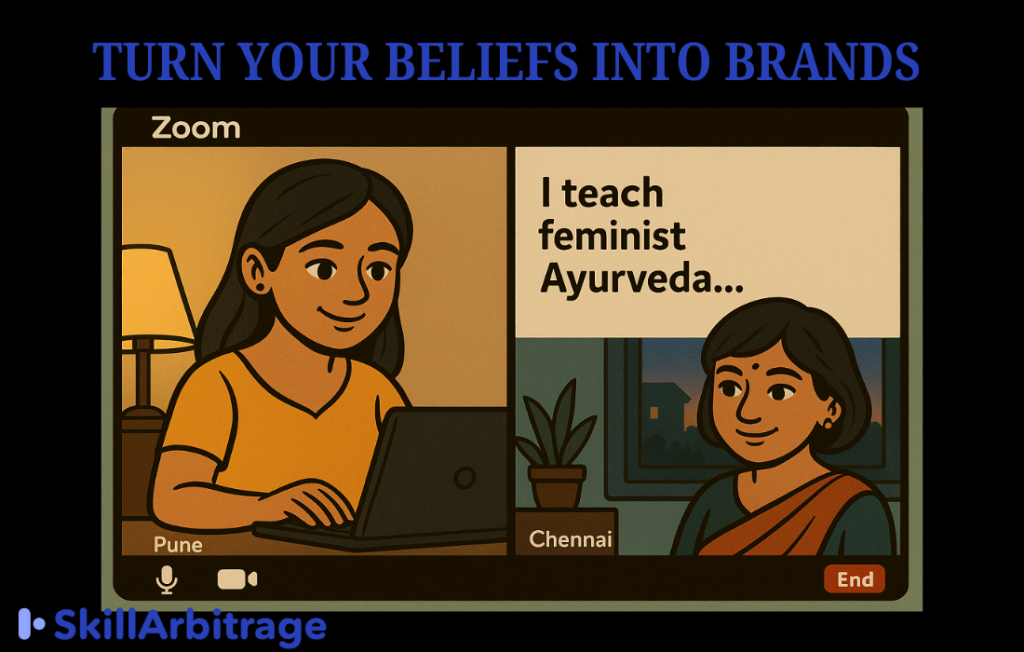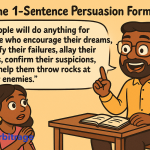This article teaches freelancers how to help indie creators, niche experts, and belief-driven brands craft manifestos that define charismatic leadership, spark movements, and build loyal tribes. If you want to stop selling services and start shaping brand futures, this framework will give you a clear, repeatable process to create manifestos that attract true believers and repel noise.
Previously in 1-Sentence Persuasion…
Parvathishankar taught Bhairavi, a feminist Ayurveda practitioner, the power of Blair Warren’s one-sentence persuasion, the five core elements that turn strangers into loyal followers. Bhairavi began seeing how deep clarity beats noisy tactics.
This time, Savitha steps in to help Bhairavi turn that clarity into a manifesto, a bold statement that defines her leadership, rallies her tribe, and sets her brand apart. You’ll learn how to craft a manifesto that sparks movements.
(Continued…)
The Zoom window flickered on. “Hey, can you see me? Can you hear me okay?” Bhairavi’s voice came soft and shaky from Pune. Her face was bathed in the warm glow of a bedside lamp, eyes tired and restless.
Savitha leaned forward in her Chennai apartment, evening light casting long shadows. “Loud and clear. You look worried. What’s going on?”
Bhairavi sighed, fingers hovering over her keyboard. “I’m stuck. I’m supposed to be writing my manifesto, the one I’ll publish on my website, Instagram, and Facebook. It’s also what I’ll speak about at the Women’s Day gathering at DY Patil College in Pune next week.”
She swallowed hard. “This speech… it’s meant to rally support for my mission, to get women fired up. But right now, my words feel flat. Like I’m shouting into a storm where nobody hears me.”
Savitha nodded, understanding the pressure. “This isn’t just another post or talk, Bhairavi. It’s your chance to create a movement. But without a manifesto that cuts through the noise, your message will drown in the crowd.”
Bhairavi’s fingers trembled. “I know what I believe in. But how do I turn that belief into words that don’t sound like empty slogans? How do I make women feel this is their fight too?”
Savitha’s voice grew steady. “Your manifesto will be your battle cry. It will live everywhere, online and in that hall at DY Patil. We need it sharp, real, and impossible to ignore.”
Bhairavi took a shaky breath. “I need a framework, something clear and practical. Right now, I’m frozen.”
Savitha smiled softly. “You’re not alone. I have the exact framework to help you build your manifesto, line by line. Let’s get started.”
1. Charismatic leader
The Zoom window stayed open as Savitha’s voice came steady. “Alright, first thing: who’s the face of this movement? Who’s going to carry this fire? You need to show up in your manifesto like you mean it. Speak in first person. Own it.”
Bhairavi hesitated for a second, then typed aloud, “My name is Bhairavi Menon. I teach feminist Ayurveda to women who’ve been dismissed and misdiagnosed their whole lives.”
Savitha nodded, “Good. That’s clear, powerful. You’re not hiding behind buzzwords or vague promises. You’re saying who you are and who you fight for.”
Bhairavi leaned back, imagining the crowded hall at DY Patil College. “I want every woman there to see me and know I’m speaking directly to them, not some distant expert, but someone who’s lived their struggles.”
“Exactly,” Savitha said. “When you say ‘I teach feminist Ayurveda,’ you’re putting a face to the cause. People don’t follow ideas. They follow people. You’re that leader.”
Bhairavi’s fingers moved faster, a flicker of confidence returning. “I’m tired of women being overlooked by traditional healthcare. My mission is to give them a voice and a system that actually listens.”
Savitha smiled. “Now you’re not just a teacher; you’re a champion for those women. This is your rallying cry. Keep it real, personal, and bold.”
Bhairavi read her words aloud again, feeling the weight and truth behind them. “My name is Bhairavi Menon. I teach feminist Ayurveda to women who’ve been dismissed and misdiagnosed their whole lives.”
The nervous knot in her chest loosened. This was the start.
2. Define the movement
The Zoom screen flickered, Bhairavi’s eyes searching Savitha’s steady gaze. “Okay, so I nailed who I am. What about the movement? How do I make people feel they belong, like this is bigger than just me?”
Savitha leaned forward, voice low but firm. “You need to make it feel like an underground wave, something raw and real that’s pushing back against the old system. Not some polished, corporate spiel. It’s a tribe, a rebellion.”
Bhairavi nodded slowly. “Got it. Something like… ‘I’m part of a growing circle of women who are reclaiming their bodies without waiting for permission from the medical-industrial complex.’”
Savitha smiled. “Perfect. That line hits hard. It names the enemy and shows your tribe is tough, independent, and fed up with the status quo. People who hear that will either jump in or step aside. That’s the point.”
Bhairavi’s fingers hovered over the keyboard before she typed it out, reading aloud, “I’m part of a growing circle of women who are reclaiming their bodies without waiting for permission from the medical-industrial complex.”
“Feel it,” Savitha said. “It’s not just a statement. It’s a badge. The people who need you are listening for that exact voice.”
Bhairavi’s chest tightened with a new energy. This was no longer just her story. It was a movement ready to rise.
3. Draw the line: us vs. them
The Zoom window was quiet for a moment before Bhairavi exhaled sharply. “Okay, so I’ve got the leader, the movement… now what? How do I make people pick a side?”
Savitha’s eyes lit up. “That’s the heart of it. You have to draw the line. It’s ‘us versus them.’ Clear and sharp. You’re not just teaching; you’re taking a stand.”
Bhairavi nodded slowly, her fingers tapping the desk. “Like… ‘We believe your period isn’t a curse. It’s a compass.’”
“Exactly,” Savitha said. “It flips the story. You’re not buying into the old shame or silence. You’re telling your tribe they’re right to feel proud and listen to their bodies.”
Bhairavi’s voice grew stronger. “And then, I say why we’re different. Something like, ‘We don’t have pharmaceutical backing or YouTube sponsors. Just ancestral knowledge and modern resistance.’ That sounds real.”
Savitha smiled. “That’s brave. You’re admitting the uphill battle, the lack of glitz or cash. But that’s what makes you fierce. People respect that honesty.”
Bhairavi hesitated, then typed, “Big wellness makes billions selling you fixes. We’re not here to fix you. We’re here to free you.”
“That’s your enemy,” Savitha said firmly. “Name who’s keeping people stuck. It’s the corporations selling quick fixes, not the slow healing you offer. When you say this, your tribe knows who to root against.”
4. Give them an identity
Bhairavi’s fingers hovered over the keyboard. “Okay, so I’ve told them who we’re against… but what do I call the women who follow this? They need a name, right?”
Savitha leaned forward, her voice warm but firm. “Yes. Every movement needs a tribe name. Something they can own, wear like a badge.”
Bhairavi bit her lip, thinking. “How about… ‘Body Literates’? Because we’re not just living in our bodies. We’re learning them. Listening deeper.”
Savitha nodded, eyes bright. “That’s it. Short, strong, and real. It tells them who they are and what they do. You want them to say, ‘I’m a Body Literate’ with pride.”
Bhairavi smiled, her confidence growing. “And maybe add something to it. Like… ‘We are Body Literates. We listen deeper. We live louder.’ It feels like a call and a promise.”
“That’s perfect,” Savitha said. “Now they have a tribe to belong to. Something that sets them apart and pulls them together.”
Bhairavi looked at the screen, the words settling in. This was no longer just a manifesto. It was an identity. A home.
5. Offer a future they can believe in
Bhairavi sat back in her chair, reading the lines aloud slowly, tasting each word.
“We imagine a world where no woman feels betrayed by her body. That world begins with you.”
Then silence.
Savitha didn’t speak right away. She let the sentence hang, giving it space.
“That’s the heart of it, Bhairavi,” she finally said. “That’s not a slogan. That’s a promise. And a challenge.”
Bhairavi nodded, eyes glassy. “I spent so many years thinking my body was broken. If I can stop even one girl from feeling that way, it’s worth it.”
“Exactly,” Savitha said. “You’re not just helping them understand Ayurveda. You’re giving them a future that doesn’t exist yet. A world where they don’t flinch at their own reflection or dread their own cycles.”
Bhairavi added another line under the sentence. Just four words:
“We’re not there yet.”
She looked up at the camera. “But we will be.”
Savitha smiled as Bhairavi finished typing the last line. There was a pause on the Zoom call, the kind that doesn’t need filling.
“Looks like you’ve got it,” Savitha said, leaning back, satisfied.
Bhairavi looked at the words on her screen. Her manifesto. Not a brochure. Not a brand story. A line in the sand.
“I thought I needed to make it sound bigger,” she said. “More polished. More… professional.”
“You don’t need polish,” Savitha said. “You need truth with teeth.”
Bhairavi laughed softly. “Feels like I just wrote my reason to keep showing up.”
“That’s exactly what it is,” Savitha said. “And when other women hear it, really hear it, they won’t just follow you. They’ll fight with you. For themselves. For each other.”
Bhairavi sat up straighter. She had a website to update. An Instagram post to write. A stage to stand on at DY Patil College, where she’d speak these words out loud to a room full of young women still learning how to trust their bodies.
She wasn’t selling a course. She was enrolling believers.
And it started with this.
(To be continued…)







 Allow notifications
Allow notifications
